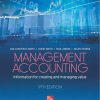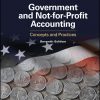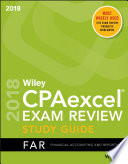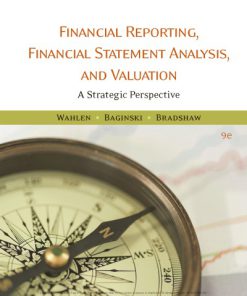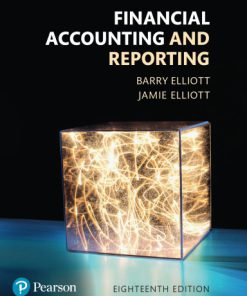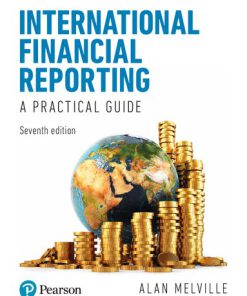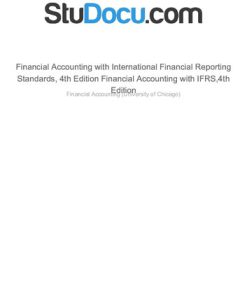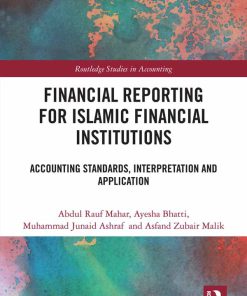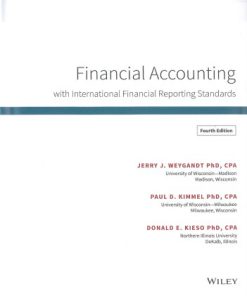Financial reporting in Australia 2nd Edition by Janice Loftus, Ken Leo, Sorin Daniliuc, Noel Boys, Belinda Luke, Hong Ang, Karyn Byrnes 0730363064 9780730363064
$50.00 Original price was: $50.00.$25.00Current price is: $25.00.
Financial reporting in Australia 2nd Edition by Janice Loftus, Ken Leo, Sorin Daniliuc, Noel Boys, Belinda Luke, Hong Ang, Karyn Byrnes – Ebook PDF Instant Download/DeliveryISBN: 0730363064, 9780730363064
Full download Financial reporting in Australia 2nd Edition after payment.
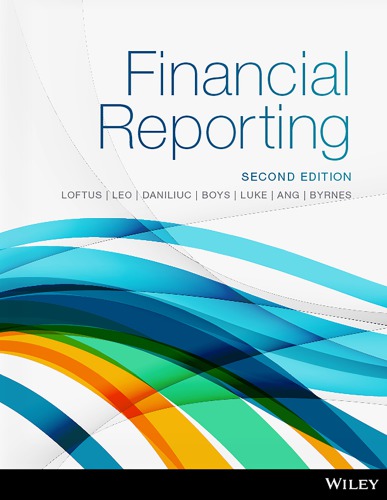
Product details:
ISBN-10 : 0730363064
ISBN-13 : 9780730363064
Author: Janice Loftus, Ken Leo, Sorin Daniliuc, Noel Boys, Belinda Luke, Hong Ang, Karyn Byrnes
Introductory financial reporting
Financial reporting in Australia 2nd table of contents:
Chapter 1 Accounting regulation and the conceptual framework
1.1 Key sources of regulation of financial reporting in Australia
1.1.1 The Corporations Act
1.1.2 Australian accounting standards
1.1.3 A conceptual framework
1.1.4 Australian Securities Exchange Listing Rules
1.1 Concept check
1.2 The role of key players in financial reporting regulation
1.2.1 Financial Reporting Council (FRC)
1.2.2 Australian Accounting Standards Board (AASB)
1.2.3 Australian Securities and Investments Commission (ASIC)
1.2.4 Australian Prudential Regulation Authority (APRA)
1.2.5 Australian Securities Exchange Group (ASX)
1.2 Concept check
1.3 The International Accounting Standards Board (IASB)
1.3 Concept check
1.4 The components of the conceptual framework
1.4.1 The objective of financial reporting
1.4.2 The reporting entity
1.4 Concept check
1.5 Qualitative characteristics of useful information
1.5.1 Fundamental qualitative characteristics
1.5.2 Enhancing qualitative characteristics
1.5.3 Cost constraint on useful financial reporting
1.5 Concept check
1.6 Going concern assumption
1.6 Concept check
1.7 Definition of the elements of financial statements
1.7.1 Assets
1.7.2 Liabilities
1.7.3 Equity
1.7.4 Income
1.7.5 Expenses
1.7 Concept check
1.8 Recognition of the elements of financial statements
1.8.1 Asset recognition
1.8.2 Liability recognition
1.8.3 Income recognition
1.8.4 Expenses recognition
1.8 Concept check
1.9 Measurement of the elements of financial statements
1.9 Concept check
1.10 Concepts of capital
1.10 Concept check
Summary
Key terms
Comprehension questions
Case study 1.1
Case study 1.2
Case study 1.3
Case study 1.4
Application and analysis exercises
References
Acknowledgements
Chapter 2 Application of accounting theory
2.1 Professional judgement in accounting
2.1 Concept check
2.2 What is an accounting policy?
2.2 Concept check
2.3 What is accounting theory?
2.3.1 Types of theories
2.3.2 Development of theories
2.3 Concept check
2.4 Positive accounting theory
2.4.1 Nexus of contracts
2.4.2 Agency theory
2.4.3 Owner–manager agency relationships
2.4.4 Manager–lender agency relationships
2.4.5 Political relationships
2.4.6 Role of accounting information in reducing agency problems
2.4.7 Implications of agency theory for accounting policy choice
2.4 Concept check
2.5 The role of accounting in capital markets
2.5.1 The mechanistic hypothesis
2.5.2 The efficient market hypothesis
2.5.3 What does accounting theory tell us about accounting policies?
2.5 Concept check
Summary
Key terms
Comprehension questions
Case study 2.1
Case study 2.2
Case study 2.3
Application and analysis exercises
References
Acknowledgements
Chapter 3 Fair value measurement
3.1 Introduction and scope
3.1 Concept check
3.2 The definition of fair value
3.2.1 Current exit price
3.2.2 Orderly transactions
3.2.3 Market participants
3.2.4 Transaction and transport costs
3.2 Concept check
3.3 Application to non-financial assets
3.3.1 Step 1: what is the particular asset being measured?
3.3.2 Step 2: what is the appropriate measurement valuation premise?
3.3.3 Step 3: what is the principal (or most advantageous market) for the asset?
3.3.4 Step 4: what is the appropriate valuation technique for the measurement of the asset?
3.3 Concept check
3.4 Application to liabilities
3.4.1 Corresponding asset approach
3.4.2 Non-performance risk and credit enhancements
3.4 Concept check
3.5 Application to an entity’s own equity instruments
3.5 Concept check
3.6 Issues relating to application to financial instruments
3.6.1 Inputs based on bid and ask prices
3.6.2 Offsetting positions
3.6 Concept check
3.7 Disclosure requirements
3.7 Concept check
Summary
Key terms
Comprehension questions
Case study 3.1
Case study 3.2
Case study 3.3
Case study 3.4
Case study 3.5
Case study 3.6
Application and analysis exercises
Reference
Acknowledgements
Chapter 4 Inventories
4.1 The nature of inventories
4.1 Concept check
4.2 Recognition and measurement of inventories
4.2 Concept check
4.3 Measurement at cost
4.3.1 Costs of purchase
4.3.2 Costs of conversion
4.3.3 Other costs
4.3.4 Estimating cost
4.3.5 Cost of inventories of a service provider
4.3.6 Inventories of not-for-profit entities
4.3 Concept check
4.4 Methods of record keeping for inventory control
4.4.1 Periodic method
4.4.2 Perpetual method
4.4 Concept check
4.5 End-of-period accounting
4.5.1 Physical count
4.5.2 Cut-off procedures
4.5.3 Goods in transit
4.5.4 Consignment inventories
4.5.5 Control account/subsidiary ledger reconciliation
4.5 Concept check
4.6 Assigning costs to inventories on sale
4.6.1 First-in, first-out (FIFO) cost formula
4.6.2 Weighted average cost formula
4.6.3 Which cost formula to use?
4.6.4 Consistent application of costing methods
4.6 Concept check
4.7 Net realisable value
4.7.1 Estimating net realisable value
4.7.2 Materials and other supplies
4.7.3 Write-down to net realisable value
4.7.4 Reversal of prior write-down to net realisable value
4.7 Concept check
4.8 Recognition as an expense
4.8 Concept check
4.9 Disclosure
4.9 Concept check
Summary
Key terms
Demonstration problems
Comprehension questions
Case study 4.1
Case study 4.2
Case study 4.3
Case study 4.4
Application and analysis exercises
References
Acknowledgements
Chapter 5 Property, plant and equipment
5.1 The nature of property, plant and equipment
5.1 Concept check
5.2 Initial recognition of PPE
5.2.1 The significant parts approach
5.2 Concept check
5.3 Initial measurement of PPE
5.3.1 Purchase price
5.3.2 Directly attributable costs
5.3.3 Acquisition for zero or nominal cost
5.3.4 Costs of dismantling, removal or restoration
5.3 Concept check
5.4 Measurement subsequent to initial recognition
5.4 Concept check
5.5 The cost model
5.5.1 Depreciation
5.5 Concept check
5.6 The revaluation model
5.6.1 Revaluation increases and decreases
5.6.2 Revaluation increases and decreases involving reversals
5.6.3 Depreciation of revalued assets
5.6 Concept check
5.7 Derecognition
5.7 Concept check
5.8 Disclosure
5.8 Concept check
Summary
Key terms
Demonstration problem
Comprehension questions
Case study 5.1
Case study 5.2
Case study 5.3
Case study 5.4
Case study 5.5
Application and analysis exercises
References
Acknowledgements
Chapter 6 Intangible assets
6.1 Introduction and scope
6.1 Concept check
6.2 The nature of intangible assets
6.2.1 Identifiable
6.2.2 Non-monetary in nature
6.2.3 Lack of physical substance
6.2 Concept check
6.3 Recognition of intangible assets
6.3 Concept check
6.4 Measurement
6.4.1 Separate acquisition
6.4.2 Acquisition as part of a business combination
6.4.3 Internally generated intangible assets
6.4.4 Internally generated goodwill
6.4.5 Examples of recognition and measurement of intangible assets
6.4 Concept check
6.5 Amortisation of intangible assets
6.5 Concept check
6.6 Measurement subsequent to initial recognition
6.6.1 Subsequent expenditure
6.6 Concept check
6.7 Disclosure
6.7 Concept check
Summary
Key terms
Demonstration problem
Comprehension questions
Case study 6.1
Case study 6.2
Application and analysis exercises
References
Acknowledgements
Chapter 7 Impairment of assets
7.1 Introduction and scope
7.1 Concept check
7.2 When to undertake an impairment test
7.2.1 Evidence of impairment
7.2 Concept check
7.3 The impairment test
7.3.1 Fair value less costs of disposal
7.3.2 Value in use
7.3 Concept check
7.4 Impairment loss: individual assets
7.4 Concept check
7.5 Impairment loss: cash-generating units
7.5.1 Identifying a cash-generating unit
7.5.2 Goodwill and CGUs
7.5.3 Impairment loss for a CGU
7.5.4 Corporate assets
7.5 Concept check
7.6 Reversal of an impairment loss
7.6.1 Individual assets
7.6.2 Cash-generating units
7.6 Concept check
7.7 Disclosure
7.7 Concept check
Summary
Key terms
Demonstration problems
Comprehension questions
Case study 7.1
Case study 7.2
Case study 7.3
Case study 7.4
Case study 7.5
Application and analysis exercises
References
Acknowledgements
Chapter 8 Provisions, contingent liabilities and contingent assets
8.1 Introduction and scope
8.1 Concept check
8.2 Definition of a provision
8.2.1 Distinguishing provisions from other liabilities
8.2 Concept check
8.3 Definition of a contingent liability
8.3.1 Distinguishing a contingent liability from a provision
8.3 Concept check
8.4 The recognition criteria for provisions
8.4.1 Putting it all together — a useful decision tree
8.4 Concept check
8.5 Measurement of provisions
8.5.1 Best estimate
8.5.2 Risks and uncertainties
8.5.3 Present value
8.5.4 Future events
8.5.5 Expected disposal of assets
8.5.6 Reimbursements
8.5.7 Changes in provisions and use of provisions
8.5 Concept check
8.6 Application of the definitions, recognition and measurement rules
8.6.1 Future operating losses
8.6.2 Onerous contracts
8.6.3 Restructuring provisions
8.6.4 Other applications
8.6 Concept check
8.7 Contingent assets
8.7 Concept check
8.8 Disclosure
8.8 Concept check
8.9 Comparison between AASB 3/IFRS 3 and AASB 137/IAS 37 in respect of contingent liabilities
8.9.1 Contingent liabilities acquired in a business combination
8.9.2 Contingent consideration in a business combination
8.9 Concept check
Summary
Key terms
Demonstration problem
Comprehension questions
Case study 8.1
Case study 8.2
Case study 8.3
Application and analysis exercises
Reference
Acknowledgements
Chapter 9 Employee benefits
9.1 Introduction to accounting for employee benefits
9.1 Concept check
9.2 Short-term employee benefits
9.2.1 Payroll
9.2.2 Accounting for the payroll
9.2.3 Accrual of wages and salaries
9.2.4 Short-term paid absences
9.2.5 Profit-sharing and bonus plans
9.2 Concept check
9.3 Post-employment benefits
9.3 Concept check
9.4 Accounting for defined contribution post-employment plans
9.4 Concept check
9.5 Accounting for defined benefit post-employment plans
9.5.1 Step 1: determine the deficit or surplus of the fund
9.5.2 Step 2: determine the amount of the net defined benefit liability (asset)
9.5.3 Step 3: determine the amounts to be recognised in profit or loss
9.5.4 Step 4: determine the remeasurements of the net defined benefit liability (asset) to be recognised in other comprehensive income
9.5 Concept check
9.6 Other long-term employment benefits
9.6 Concept check
9.7 Termination benefits
9.7 Concept check
Summary
Key terms
Demonstration problem
Comprehension questions
Case study 9.1
Case study 9.2
Case study 9.3
Case study 9.4
Application and analysis exercises
References
Acknowledgements
Chapter 10 Leases
10.1 Introduction and scope
10.1 Concept check
10.2 What is a lease?
10.2 Concept check
10.3 Accounting for leases by lessees
10.3.1 Initial recognition
10.3.2 Subsequent measurement
10.3.3 Accounting for executory costs
10.3 Concept check
10.4 Classifying leases by lessor
10.4.1 Classification guidance
10.4.2 Further classification of finance leases by lessor
10.4 Concept check
10.5 Accounting for finance leases by financier lessors
10.5.1 Initial recognition
10.5.2 Subsequent measurement
10.5 Concept check
10.6 Accounting for finance leases by manufacturer or dealer lessors
10.6.1 Initial recognition
10.6.2 Subsequent measurement
10.6 Concept check
10.7 Accounting for operating leases by lessors
10.7.1 Lease receipts
10.7.2 Initial direct costs
10.7.3 Depreciation of underlying assets
10.7 Concept check
10.8 Disclosure requirements
10.8.1 Disclosures required by lessees
10.8.2 Disclosures required by lessors
10.8 Concept check
Summary
Key terms
Demonstration problems
Comprehension questions
Case study 10.1
Case study 10.2
Case study 10.3
Application and analysis exercises
Reference
Acknowledgements
Chapter 11 Financial instruments
11.1 Introduction to financial instruments
11.1.1 Transactions that result in financial instruments
11.1.2 Transactions that do not result in financial instruments
11.1 Concept check
11.2 Financial assets
11.2 Concept check
11.3 Financial liabilities
11.3 Concept check
11.4 Derivative instruments
11.4.1 Hybrid contracts with embedded derivatives
11.4 Concept check
11.5 What is an equity instrument?
11.5 Concept check
11.6 Distinguishing between financial liabilities and equity instruments
11.6.1 Ordinary shares and preference shares
11.6.2 Contingent settlement provisions
11.6.3 Contracts involving a company’s own equity instruments
11.6 Concept check
11.7 Compound financial instruments — convertible notes
11.7 Concept check
11.8 Consequential effects of classifications for interest, dividends, gains and losses
11.8 Concept check
11.9 Recognition of financial asset or financial liability
11.9.1 Subject to contractual provisions
11.9.2 Recognition of regular way purchases or sales of a financial asset
11.9 Concept check
11.10 Offsetting a financial asset and a financial liability
11.10 Concept check
11.11 Derecognition of a financial asset or a financial liability
11.11.1 Derecognition of financial asset
11.11.2 Derecognition of financial liability
11.11 Concept check
11.12 Initial measurement of a financial asset or a financial liability
11.12.1 Initial measurement of a financial asset
11.12.2 Initial measurement of a financial liability
11.12 Concept check
11.13 Subsequent measurement of a financial asset
11.13.1 Summary of requirements
11.13.2 Measurement of financial assets at amortised cost
11.13.3 Measurement of financial assets at fair value
11.13.4 Reclassification of financial assets
11.13 Concept check
11.14 Impairment of financial assets
11.14 Concept check
11.15 Subsequent measurement of a financial liability
11.15.1 Summary of requirements
11.15.2 Measurement of financial liabilities at amortised cost
11.15.3 Measurement of financial liabilities at fair value
11.15 Concept check
11.16 Disclosures
11.16.1 Significance of financial instruments to financial position/performance
11.16.2 Risks arising from financial instruments and their management
11.16 Concept check
Summary
Key terms
Demonstration problems
Comprehension questions
Case study 11.1
Case study 11.2
Application and analysis exercises
References
Acknowledgements
Chapter 12 Income taxes
12.1 Introduction and scope
12.1 Concept check
12.2 Differences between accounting profit and taxable profit
12.2 Concept check
12.3 Current and future tax consequences of transactions and other events
12.3 Concept check
12.4 Calculation of current tax
12.4.1 Tax losses
12.4 Concept check
12.5 Calculation of deferred tax
12.5.1 Step 1: determining carrying amounts
12.5.2 Step 2: determining tax bases
12.5.3 Step 3: determining and classifying temporary differences
12.5.4 Step 4(a): determining the closing balances of deferred tax assets and deferred tax liabilities
12.5.5 Step 4(b): determining the adjustments in deferred tax asset and deferred tax liability accounts
12.5.6 Step 4(c): preparing the adjustment entry
12.5.7 Recognition criteria for deferred tax assets and liabilities
12.5.8 Other movements in deferred tax accounts in the current period
12.5.9 Offsetting tax assets and liabilities
12.5 Concept check
12.6 Changes in tax rates
12.6 Concept check
12.7 Disclosure requirements
12.7 Concept check
Summary
Key terms
Demonstration problem
Comprehension questions
Case study 12.1
Case study 12.2
Case study 12.3
Case study 12.4
Case study 12.5
Case study 12.6
Application and analysis exercises
Reference
Acknowledgements
Chapter 13 Share capital and reserves
13.1 Equity
13.1 Concept check
13.2 Types of companies
13.2.1 Not-for-profit companies
13.2.2 For-profit companies
13.2 Concept check
13.3 Key features of the corporate structure
13.3.1 The use of share capital
13.3.2 Limited liability
13.3.3 Par value and no-par value shares
13.3 Concept check
13.4 Different forms of share capital
13.4.1 Ordinary shares
13.4.2 Preference shares
13.4 Concept check
13.5 Contributed equity: issue of share capital
13.5.1 Issue of shares
13.5.2 Oversubscriptions
13.5 Concept check
13.6 Contributed equity: subsequent movements in share capital
13.6.1 Placements of shares
13.6.2 Rights issues
13.6.3 Share purchase plans
13.6.4 Dividend reinvestment plans
13.6.5 Options
13.6.6 Bonus issues
13.6.7 Capital raising in Australia
13.6 Concept check
13.7 Share capital: share buybacks
13.7.1 Treasury shares
13.7 Concept check
13.8 Reserves
13.8.1 Retained earnings
13.8.2 Other components of equity
13.8 Concept check
13.9 Disclosure
13.9.1 Specific disclosures
13.9.2 Statement of changes in equity
13.9 Concept check
Summary
Key terms
Demonstration problems
Comprehension questions
Case study 13.1
Case study 13.2
Case study 13.3
Application and analysis exercises
References
Acknowledgements
Chapter 14 Share-based payment
14.1 Share-based payment transactions
14.1 Concept check
14.2 Cash-settled and equity-settled share-based payment transactions
14.2 Concept check
14.3 Recognition
14.3 Concept check
14.4 Equity-settled share-based payment transactions
14.4.1 Transactions in which services are received
14.4.2 Transactions measured by reference to the fair value of the equity instruments granted
14.4 Concept check
14.5 Vesting
14.5.1 Treatment of vesting conditions
14.5.2 Treatment of non-vesting conditions
14.5 Concept check
14.6 Treatment of a reload feature
14.6 Concept check
14.7 Modifications to terms and conditions on which equity instruments were granted
14.7.1 Repurchases
14.7 Concept check
14.8 Cash-settled share-based payment transactions
14.8.1 Share-based payment transactions with cash alternatives
14.8 Concept check
14.9 Disclosure
14.9 Concept check
Summary
Key terms
Demonstration problems
Comprehension questions
Case study 14.1
Case study 14.2
Case study 14.3
Application and analysis exercises
Reference
Acknowledgements
Chapter 15 Revenue
15.1 The scope of AASB 15/IFRS 15
15.1 Concept check
15.2 The definitions of income and revenue
15.2.1 Income
15.2.2 Revenue
15.2.3 Ordinary activities and gross inflows
15.2 Concept check
15.3 The steps in recognising revenue
15.3.1 Step 1: identify the contract or contracts with the customer
15.3.2 Step 2: identify the performance obligations in the contract
15.3.3 Step 3: determine the transaction price
15.3.4 Step 4: Allocate the transaction price to the performance obligation
15.3.5 Step 5: Recognise revenue when (or as) the entity satisfies a performance obligation
15.3 Concept check
15.4 The recognition criteria
15.4.1 The recognition criteria for income generally
15.4.2 Sale of goods
15.4.3 Rendering of services
15.4 Concept check
15.5 Revenue recognition issues in various industries in practice
15.5.1 The principal/agent distinction
15.5.2 Telecommunications
15.5.3 Retail
15.5.4 Airline
15.5 Concept check
15.6 Disclosure requirements of AASB 15/IFRS 15
15.6 Concept check
Summary
Key terms
Demonstration problem
Comprehension questions
Case study 15.1
Case study 15.2
Case study 15.3
Application and analysis exercises
References
Acknowledgements
Chapter 16 Presentation of financial statements
16.1 Components of financial statements
16.1 Concept check
16.2 General features of financial statements
16.2.1 Fair presentation and compliance with standards
16.2.2 Going concern
16.2.3 Accrual basis of accounting
16.2.4 Materiality and aggregation
16.2.5 Offsetting
16.2.6 Frequency of reporting
16.2.7 Comparative information
16.2.8 Consistency of presentation
16.2 Concept check
16.3 Statement of financial position
16.3.1 Statement of financial position classifications
16.3.2 Information required to be presented in the statement of financial position
16.3.3 Information required to be presented in the statement of financial position or in the notes
16.3.4 Limitations of the statement of financial position
16.3 Concept check
16.4 Statement of profit or loss and other comprehensive income
16.4.1 Items of comprehensive income
16.4.2 Information required to be presented in the statement of profit or loss and other comprehensive income
16.4.3 Information required to be presented in the statement of profit or loss and other comprehensive income or in the notes
16.4.4 Illustrative statements of profit or loss and other comprehensive income
16.4 Concept check
16.5 Statement of changes in equity
16.5.1 Presentation of the statement of changes in equity
16.5.2 Information required to be reported in the statement of changes in equity
16.5 Concept check
16.6 Notes
16.6.1 Compliance with IFRSs and Australian accounting standards
16.6.2 Statement of significant accounting policies
16.6.3 Information about capital
16.6.4 Other disclosures
16.6.5 Illustrative examples of financial statements
16.6 Concept check
Summary
Key terms
Demonstration problems
Comprehension questions
Case study 16.1
Case study 16.2
Case study 16.3
Case study 16.4
Application and analysis exercises
References
Acknowledgements
Chapter 17 Statement of cash flows
17.1 Purpose of a statement of cash flows
17.1 Concept check
17.2 Defining cash and cash equivalents
17.2 Concept check
17.3 Classifying cash flow activities
17.3.1 Classifying interest and dividends received and paid
17.3.2 Classifying taxes on income
17.3 Concept check
17.4 Format of the statement of cash flows
17.4.1 Reporting cash flows from operating activities
17.4.2 Reporting cash flows from investing and financing activities
17.4.3 Reporting cash flows on a net basis
17.4 Concept check
17.5 Preparing a statement of cash flows
17.5.1 Cash flows from operating activities
17.5.2 Cash flows from investing activities
17.5.3 Cash flows from financing activities
17.5 Concept check
17.6 Other disclosures
17.6.1 Components of cash and cash equivalents
17.6.2 Changes in ownership interests of subsidiaries and other businesses
17.6.3 Non-cash transactions
17.6.4 Disclosures that are encouraged but not required
17.6 Concept check
Summary
Key terms
Demonstration problem
Comprehension questions
Case study 17.1
Case study 17.2
Case study 17.3
Application and analysis exercises
Reference
Acknowledgements
Chapter 18 Accounting policies and other disclosures
18.1 Accounting policies
18.1.1 Disclosure of accounting policies
18.1.2 Disclosure of changes in accounting policies
18.1 Concept check
18.2 Changes in accounting estimates
18.2 Concept check
18.3 Errors
18.3 Concept check
18.4 Impracticability in respect of retrospective adjustments for accounting policy changes or correction of errors
18.4 Concept check
18.5 Materiality
18.5 Concept check
18.6 Events occurring after the end of the reporting period
18.6 Concept check
Summary
Key terms
Demonstration problems
Comprehension questions
Case study 18.1
Case study 18.2
Case study 18.3
Case study 18.4
Case study 18.5
Application and analysis exercises
References
Acknowledgements
Chapter 19 Earnings per share
19.1 Objective of AASB 133/IAS 33
19.1 Concept check
19.2 Application and scope
19.2 Concept check
19.3 Basic earnings per share
19.3.1 Earnings
19.3.2 Shares
19.3 Concept check
19.4 Diluted earnings per share
19.4.1 Earnings
19.4.2 Shares
19.4 Concept check
19.5 Retrospective adjustments
19.5 Concept check
19.6 Disclosure
19.6 Concept check
Summary
Key terms
Demonstration problem
Comprehension questions
Case study 19.1
Case study 19.2
Case study 19.3
Application and analysis exercises
Reference
Acknowledgements
Chapter 20 Operating segments
20.1 Objectives of financial reporting by segments
20.1 Concept check
20.2 Scope
20.2 Concept check
20.3 A controversial standard
20.3 Concept check
20.4 Operating segments
20.4 Concept check
20.5 Reportable segments
20.5.1 Identifying reportable segments
20.5.2 Applying the definition of reportable segments
20.5 Concept check
20.6 Disclosure
20.6.1 General information
20.6.2 Information about profit or loss, assets and liabilities
20.6.3 Measurement
20.6.4 Reconciliations
20.6.5 Entity-wide disclosures
20.6.6 Comparative information
20.6 Concept check
20.7 Applying the disclosures in practice
20.7 Concept check
Summary
Key terms
Comprehension questions
Case study 20.1
Case study 20.2
Application and analysis exercises
References
Acknowledgements
Chapter 21 Related party disclosures
21.1 Objective, application and scope of AASB 124/IAS 24
21.1 Concept check
21.2 Identifying related parties
21.2.1 A close member of the family of a person
21.2.2 Control, joint control, significant influence
21.2.3 Key management personnel
21.2.4 An associate of the entity
21.2.5 A joint venture
21.2.6 Post-employment benefit plan
21.2 Concept check
21.3 Relationships that are not related parties
21.3 Concept check
21.4 Disclosure
21.4.1 Related party transactions and related party relationships
21.4 Concept check
21.5 Government-related entities
21.5 Concept check
Summary
Key terms
Comprehension questions
Case study 21.1
Case study 21.2
Case study 21.3
Application and analysis exercises
References
Acknowledgements
Chapter 22 Sustainability and corporate social responsibility reporting
22.1 Sustainability and corporate social responsibility
22.1.1 Origins of sustainability and corporate social responsibility
22.1.2 Reasons for adopting sustainable and corporate social responsibility practices
22.1 Concept check
22.2 Stakeholder influences
22.2.1 Ethical investment
22.2 Concept check
22.3 Sustainability reporting
22.3.1 Integrated reporting
22.3.2 Environmental reporting
22.3 Concept check
22.4 Guidelines for sustainability and CSR reporting
22.4.1 Global Reporting Initiative
22.4.2 Mandatory sustainability and CSR reporting requirements
22.4.3 Social and environmental management systems
22.4 Concept check
22.5 Climate change and accounting
22.5.1 Emissions reduction schemes
22.5.2 Accounting for carbon emissions
22.5 Concept check
Summary
Key terms
Comprehension questions
Case study 22.1
Case study 22.2
Case study 22.3
Case study 22.4
Case study 22.5
Application and analysis exercises
References
Acknowledgements
Chapter 23 Foreign currency transactions and forward exchange contracts
23.1 The need for translation of foreign currency transactions
23.1.1 Functional currency
23.1.2 Types of foreign currency transactions
23.1 Concept check
23.2 Exchange rates
23.2 Concept check
23.3 Initial measurement at the transaction date
23.3 Concept check
23.4 Monetary and non-monetary items
23.4 Concept check
23.5 Foreign exchange differences for monetary items
23.5.1 Realised and unrealised gains or losses from exchange differences
23.5.2 The relationship between exchange rates and exchange differences
23.5 Concept check
23.6 Subsequent measurement of foreign currency monetary items
23.6.1 Measurement of foreign currency monetary items at the end of the reporting period
23.6.2 Measurement of foreign currency monetary items at settlement date
23.6.3 Illustrative examples
23.6 Concept check
23.7 Subsequent measurement of foreign currency non-monetary items
23.7.1 Qualifying assets
23.7.2 Revalued assets
23.7.3 Inventories write-downs and impairment
23.7 Concept check
23.8 Foreign exchange risk
23.8 Concept check
23.9 Forward exchange contracts
23.9.1 The nature of a forward contract
23.9.2 The fair value of a forward contract
23.9.3 Accounting where there is no hedging relationship
23.9 Concept check
23.10 Forward exchange contracts with hedging
23.10.1 Hedging relationships that qualify for hedge accounting
23.10.2 Accounting for hedging relationships
23.10 Concept check
23.11 Disclosures
23.11 Concept check
Summary
Key terms
Demonstration problems
Comprehension questions
Case study 23.1
Case study 23.2
Application and analysis exercises
Acknowledgements
Chapter 24 Translation of foreign currency financial statements
24.1 Introduction and scope
24.1 Concept check
24.2 Functional and presentation currencies
24.2.1 Functional currency
24.2.2 Identifying the functional currency of a foreign operation
24.2 Concept check
24.3 The translation process
24.3 Concept check
24.4 Translation into the functional currency — the temporal method
24.4 Concept check
24.5 Translation from the functional currency into the presentation currency — the current rate method
24.5.1 Choice of a presentation currency
24.5 Concept check
24.6 Disclosure
24.6 Concept check
Summary
Key terms
Demonstration problem
Comprehension questions
Case study 24.1
Case study 24.2
Case study 24.3
Case study 24.4
Case study 24.5
Case study 24.6
Application and analysis exercises
References
Acknowledgements
Chapter 25 Business combinations
25.1 Objective of AASB 3/IFRS 3
25.1 Concept check
25.2 Determining whether a transaction is a business combination
25.2 Concept check
25.3 The acquisition method
25.3 Concept check
25.4 Step 1: Identify the acquirer
25.4 Concept check
25.5 Step 2: Determine the acquisition date
25.5 Concept check
25.6 Step 3: Recognise and measure identifiable assets acquired and liabilities assumed
25.6.1 Recognition
25.6.2 Measurement
25.6 Concept check
25.7 Step 4: Recognise and measure goodwill and a gain on bargain purchase
25.7.1 Consideration transferred
25.7.2 Acquisition-related costs
25.7.3 Goodwill
25.7.4 Gain on bargain purchase
25.7 Concept check
25.8 Disclosures
25.8 Concept check
Summary
Key terms
Demonstration problem
Comprehension questions
Case study 25.1
Case study 25.2
Case study 25.3
Case study 25.4
Case study 25.5
Application and analysis exercises
References
Acknowledgements
Chapter 26 Consolidation: controlled entities
26.1 Consolidated financial statements
26.1 Concept check
26.2 Control
26.2.1 Power
26.2.2 Exposure or rights to variable returns
26.2.3 Ability to use power to affect returns
26.2.4 Agents
26.2 Concept check
26.3 Consolidation process
26.3 Concept check
26.4 Circumstances where a parent may not prepare consolidated financial statements
26.4 Concept check
26.5 Disclosure
26.5.1 Disclosures required by AASB 12/IFRS 12
26.5.2 Disclosures required by AASB 127/IAS 27
26.5 Concept check
Summary
Key terms
Comprehension questions
Case study 26.1
Case study 26.2
Case study 26.3
Application and analysis exercises
References
Acknowledgements
Chapter 27 Consolidation: wholly owned entities
27.1 Consolidation process in the case of wholly owned entities
27.1 Concept check
27.2 Consolidation worksheets
27.2 Concept check
27.3 The acquisition analysis
27.3.1 Parent has no previously held equity interest in the subsidiary
27.3.2 Parent has previously held equity interest in the subsidiary
27.3 Concept check
27.4 Consolidation worksheet entries at the acquisition date
27.4.1 Business combination valuation entries
27.4.2 Pre-acquisition entries
27.4.3 Consolidation worksheet
27.4.4 Subsidiary has recorded goodwill at acquisition date
27.4.5 Subsidiary has recorded dividends at acquisition date
27.4.6 Gain on bargain purchase
27.4 Concept check
27.5 Consolidation worksheet entries subsequent to the acquisition date
27.5.1 Business combination valuation entries
27.5.2 Pre-acquisition entries
27.5 Concept check
27.6 Consolidation worksheet entries when the subsidiary revalues its assets at acquisition date
27.6 Concept check
27.7 Disclosure
27.7 Concept check
Summary
Key terms
Demonstration problems
Comprehension questions
Case study 27.1
Case study 27.2
Case study 27.3
Case study 27.4
Case study 27.5
Application and analysis exercises
Acknowledgements
Chapter 28 Consolidation: intragroup transactions
28.1 The need for intragroup adjustments
28.1 Concept check
28.2 The adjustment process
28.2 Concept check
28.3 Inventories
28.3.1 Sales of inventories in the current period
28.3.2 Sales of inventories in the prior period
28.3 Concept check
28.4 Property, plant and equipment
28.4.1 Sale of property, plant and equipment
28.4.2 Depreciation and realisation of profits
28.4.3 Change in classification of transferred assets
28.4 Concept check
28.5 Intragroup services
28.5.1 Example
28.5.2 Realisation of intragroup profits or losses
28.5 Concept check
28.6 Dividends
28.6.1 Dividends declared in the current period but not paid
28.6.2 Dividends declared and paid in the current period
28.6.3 Bonus share dividends
28.6 Concept check
28.7 Intragroup borrowings
28.7.1 Example
28.7 Concept check
Summary
Key terms
Demonstration problem
Comprehension questions
Case study 28.1
Case study 28.2
Application and analysis exercises
Acknowledgements
Chapter 29 Consolidation: non-controlling interest
29.1 The nature of a non-controlling interest
29.1 Concept check
29.2 Measurement and disclosure of the NCI share of equity
29.2.1 Measurement of the NCI share of equity
29.2.2 Disclosure of NCI
29.2 Concept check
29.3 The consolidation worksheet in the presence of NCI
29.3 Concept check
29.4 The effects of the NCI on the goodwill recognised in the consolidation process
29.4.1 Full goodwill method
29.4.2 Partial goodwill method
29.4.3 Analysing the two methods
29.4 Concept check
29.5 Calculating the NCI share of recorded equity
29.5.1 Basic principles
29.5.2 Step 1: measurement of the NCI at acquisition date
29.5.3 Step 2: measurement of the NCI share of changes in equity between acquisition date and beginning of the current period
29.5.4 Step 3: measurement of the NCI share of changes in equity in the current period
29.5.5 Posting the NCI entries into the consolidation worksheet
29.5 Concept check
29.6 Adjusting NCI for the effects of intragroup transactions
29.6 Concept check
29.7 Gain on bargain purchase
29.7 Concept check
29.8 Disclosure
29.8 Concept check
Summary
Key term
Demonstration problem
Comprehension questions
Case study 29.1
Case study 29.2
Case study 29.3
Case study 29.4
Case study 29.5
Application and analysis exercises
Reference
Acknowledgements
Chapter 30 Consolidation: other issues
30.1 Introduction and scope
30.1 Concept check
30.2 Direct and indirect non-controlling interest
30.2 Concept check
30.3 Preparing consolidated financial statements for a multiple subsidiary structure
30.3.1 Calculation of the NCI share of equity
30.3.2 The effects of intragroup transactions on the calculation of the NCI
30.3.3 Dividends
30.3 Concept check
30.4 Non-sequential acquisitions
30.4 Concept check
30.5 Changes in ownership interests by a parent in a group
30.5.1 Changes in ownership interests without loss of control
30.5.2 Acquisition of additional shares by the parent subsequent to date of acquisition
30.5.3 Sale of shares by parent with retention of control
30.5.4 Changes in ownership interests with loss of control
30.5.5 Disclosures relating to changes in ownership interests
30.5 Concept check
Summary
Key terms
Demonstration problems
Comprehension questions
Case study 30.1
Case study 30.2
Case study 30.3
Application and analysis exercises
Acknowledgements
Chapter 31 Associates and joint ventures
31.1 Introduction and scope
31.1 Concept check
31.2 Identifying associates and joint ventures
31.2.1 Associates
31.2.2 Joint ventures
31.2 Concept check
31.3 The equity method of accounting: rationale and application
31.3.1 Rationale for the equity method
31.3.2 Application of the equity method: consolidation worksheet or investor’s accounts
31.3 Concept check
31.4 Applying the equity method: basic principles
31.4 Concept check
31.5 Applying the equity method: goodwill and fair value adjustments
31.5.1 Applying the equity method across multiple years
31.5 Concept check
31.6 Applying the equity method — inter-entity transactions
31.6.1 Examples of inter-entity transactions
31.6 Concept check
31.7 Share of losses of an associate or joint venture
31.7 Concept check
31.8 Disclosure
31.8 Concept check
Summary
Key terms
Comprehension questions
Case study 31.1
Case study 31.2
Case study 31.3
Case study 31.4
Case study 31.5
Application and analysis exercises
References
Acknowledgements
Chapter 32 Joint arrangements
32.1 Introduction and scope
32.1 Concept check
32.2 Joint arrangements: characteristics and classification
32.2.1 The characteristics of a joint arrangement
32.2.2 The classification of a joint arrangement
32.2 Concept check
32.3 Accounting for joint arrangements
32.3.1 Accounting by the joint operation itself
32.3 Concept check
32.4 Accounting by a joint operator
32.4.1 Contributions of cash to a joint operation
32.4.2 Contributions of assets to a joint operation
32.4.3 Management fees paid to a joint operator
32.4 Concept check
32.5 Disclosure
32.5 Concept check
Summary
Key terms
Demonstration problem
Comprehension questions
Case study 32.1
Case study 32.2
Case study 32.3
Case study 32.4
Application and analysis exercises
References
Acknowledgements
Chapter 33 Insolvency and liquidation
33.1 Insolvency
33.1 Concept check
33.2 Receivership
33.2 Concept check
33.3 Administration
33.3 Concept check
33.4 Liquidation
33.4.1 Winding up by the court
33.4.2 Voluntary winding up
33.4 Concept check
33.5 Powers of a liquidator
33.5 Concept check
33.6 Identifying the company’s debts on liquidation
33.6 Concept check
33.7 Ranking the company’s debts on liquidation
33.7.1 Secured creditors
33.7.2 Preferential unsecured creditors
33.7.3 Ordinary unsecured creditors
33.7.4 Deferred creditors
33.7 Concept check
33.8 Rights of contributories on liquidation
33.8.1 Insufficient funds to pay creditors
33.8.2 Sufficient funds to pay creditors, but not to repay all share capital to contributories
33.8.3 Surplus funds over and above creditors’ and contributories’ claims
33.8.4 Calls in advance and arrears of dividends
33.8 Concept check
33.9 Accounting for liquidation
33.9.1 Reports prepared by the company for the liquidator
33.9.2 Realisation of the assets
33.9.3 Possession of assets by secured creditors
33.9.4 Payment to other creditors in order of priority
33.9.5 Return of capital to contributories
33.9 Concept check
Summary
Key terms
Demonstration problems
Comprehension questions
Case study 33.1
Case study 33.2
Application and analysis exercises
Acknowledgements
Chapter 34 Accounting for mineral resources
34.1 Mineral resources in context
34.1 Concept check
34.2 Objective of AASB 6/IFRS 6
34.2 Concept check
34.3 Scope of AASB 6/IFRS 6
34.3 Concept check
34.4 Recognition of exploration and evaluation assets
34.4.1 Temporary exemption from AASB 108/IAS 8 paragraphs 11 and 12
34.4.2 Treatment of exploration and evaluation expenditures in Australia
34.4 Concept check
34.5 Measurement of exploration and evaluation assets
34.5.1 Measurement at recognition
34.5.2 Obligations for removal and restoration
34.5.3 Measurement after recognition
34.5.4 Changes in accounting policies
34.5.5 Depreciation and amortisation
34.5 Concept check
34.6 Presentation
34.6.1 Classification of E&E assets
34.6.2 Reclassification of E&E assets
34.6 Concept check
34.7 Impairment
34.7.1 Recognition and measurement
34.7.2 Specifying the level at which E&E assets are assessed for impairment
34.7 Concept check
34.8 Disclosure
34.8 Concept check
34.9 Developments and contemporary issues
34.9.1 Accounting for waste removal costs
34.9.2 The IASB’s extractive activities project
34.9 Concept check
Summary
Key terms
Comprehension questions
Case study 34.1
Case study 34.2
Case study 34.3
Application and analysis exercises
References
Acknowledgements
Chapter 35 Agriculture
35.1 Introduction to AASB 141/IAS 41
35.1 Concept check
35.2 Scope and key definitions
35.2.1 Scope
35.2.2 Key definitions
35.2 Concept check
35.3 The harvest distinction
35.3 Concept check
35.4 The recognition criteria for biological assets and agricultural produce
35.4.1 The recognition criteria
35.4.2 The problem with ‘control’
35.4 Concept check
35.5 Measurement at fair value
35.5.1 Measurement requirement
35.5.2 Arguments for and against the use of fair value
35.5.3 How to apply the fair value measurement requirement
35.5.4 Gains and losses
35.5 Concept check
35.6 Practical implementation issues with the use of fair value
35.6.1 Immature biological assets
35.6.2 Disclosure practices
35.6 Concept check
35.7 Government grants
35.7 Concept check
35.8 The interaction between AASB 141/IAS 41 and AASB 116/IAS 16 and AASB 140/IAS 40
35.8 Concept check
35.9 Disclosure requirements
35.9.1 General disclosures
35.9.2 Additional disclosures for biological assets where fair value cannot be measured reliably
35.9.3 Government grants
35.9 Concept check
35.10 Preparing financial statements when applying AASB 141/IAS 41
35.10 Concept check
People also search for Financial reporting in Australia 2nd:
financial reporting framework in australia
financial reporting standards in australia
financial reporting period in australia
financial reporting roles in australia
what are the financial reporting requirements in australia
Tags: Financial reporting, Australia, Janice Loftus, Ken Leo, Sorin Daniliuc, Noel Boys, Belinda Luke, Hong Ang, Karyn Byrnes
You may also like…
Business & Economics
Business & Economics
Business & Economics - Accounting
Business & Economics - Accounting
Financial accounting and reporting Seventeenth Edition Elliott
Business & Economics - Accounting
International financial reporting 7th Edition by Alan Melville 1292293128 9781292293127
Business & Economics - Accounting
Business & Economics - Accounting
Financial Statements Analysis and Reporting 1st edition by Felix Lessambo 3319999845 9783319999845
Business & Economics - Accounting
Business & Economics - Accounting


